
A well-structured blog outline not only guides your writing process but also enhances the reading experience of your posts.
A blog outline helps organize your thoughts but also ensures that your article flows logically from one point to the next.
In this article, we'll walk you through the 5 steps to create a winning blog outline, and we'll also share some valuable tips from pro bloggers and marketers who create blog outlines on a daily basis.
What is a Blog Outline?
A blog outline is a structured framework that lays out the main points and flow of a blog post before the actual writing begins.
Think of it as the skeleton that provides support and shape to your article.
Is a Blog Outline the Same as a Content Brief?
No, a blog outline and a content brief are related, but they’re not the same thing.
A blog outline is a detailed plan that focuses on the structure and flow of a specific blog post.
It’s about organizing the main ideas, headings, and subheadings to ensure that the content is coherent and logically ordered. Essentially, a blog outline is a writer’s tool for drafting a post.
On the other hand, a content brief is broader. It’s a document that provides general guidelines and essential information for creating content.
A content brief might include details about the target audience, target length, tone of voice, key messages, SEO keywords, and the main objectives of the content.
But most importantly, the content brief tends to include the blog outline. For instance, check this article content brief we created for our piece on programmatic SEO. It contains the blog outline for that topic.
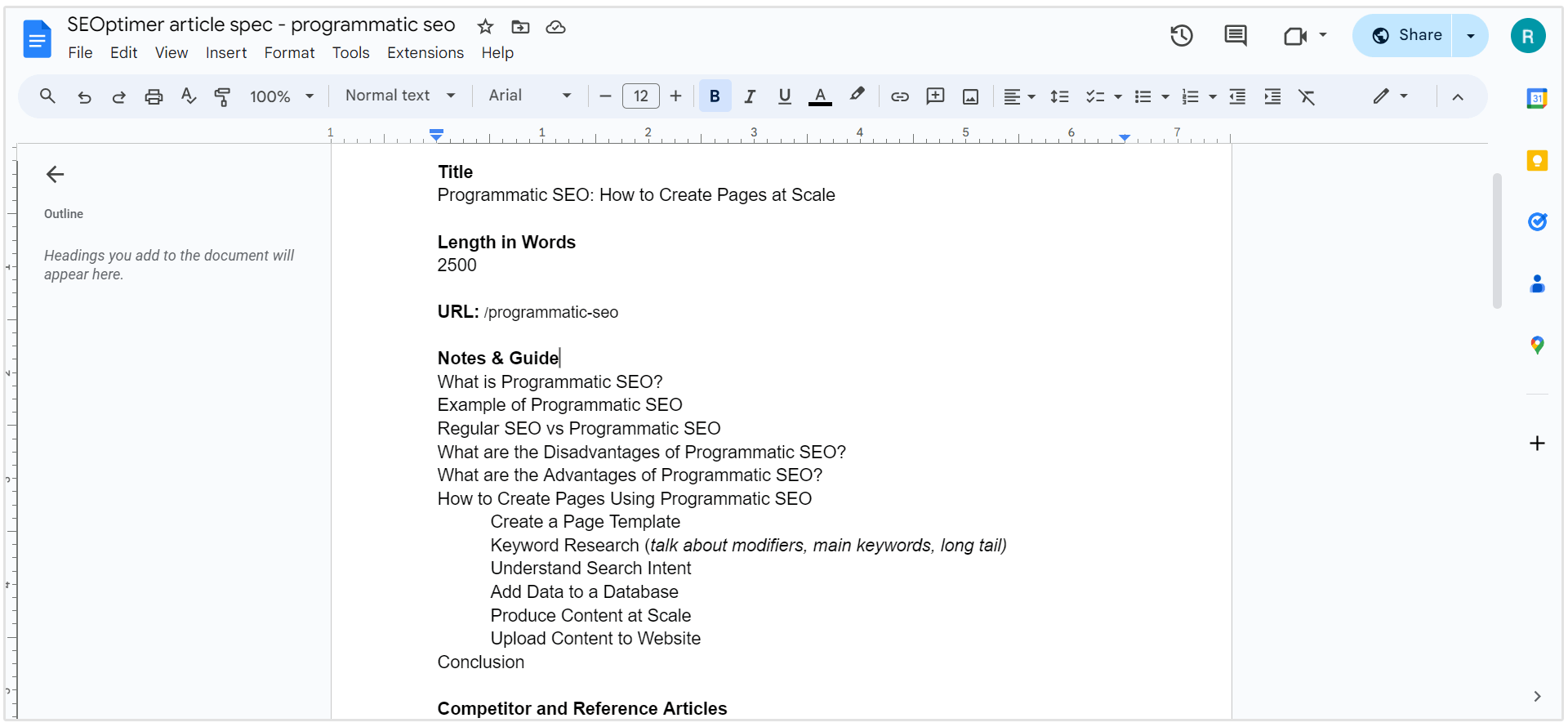
By including the blog outline in the content brief we can give our team of writers a clear picture of what we expect from each brief we send them.
It’s often used by content creators, including writers, marketers, and SEO teams to ensure that everyone involved in the project is aligned.
In simple terms, the content brief defines the “what” and “why” of the content, while the blog outline takes it further by detailing the “how” of writing a specific blog post.
Why Create a Blog Outline?
You might wonder why you should even bother creating a blog post outline? I mean, you could just start writing.
Creating a blog outline can seem like an extra step, but it's a very important part of the writing process. It involves listing key headings, subheadings, and bullet points for the main ideas you want to cover.
The key to producing good blog content is a properly structured outline.
- Brandon Schroth, Founder at Reporter Outreach
This approach not only shapes your content logically but also saves time by reducing the need for major revisions later on.
The purpose of a blog outline is to give your post a clear direction, making it easier to maintain focus on the topic.
It also enhances readability by breaking the content into manageable sections, keeping readers engaged.
Bonus tip: If you want to check the readability of your blog posts, check out Hemingway App. This tool analyzes your text and gives you a score of how easy it is to read.
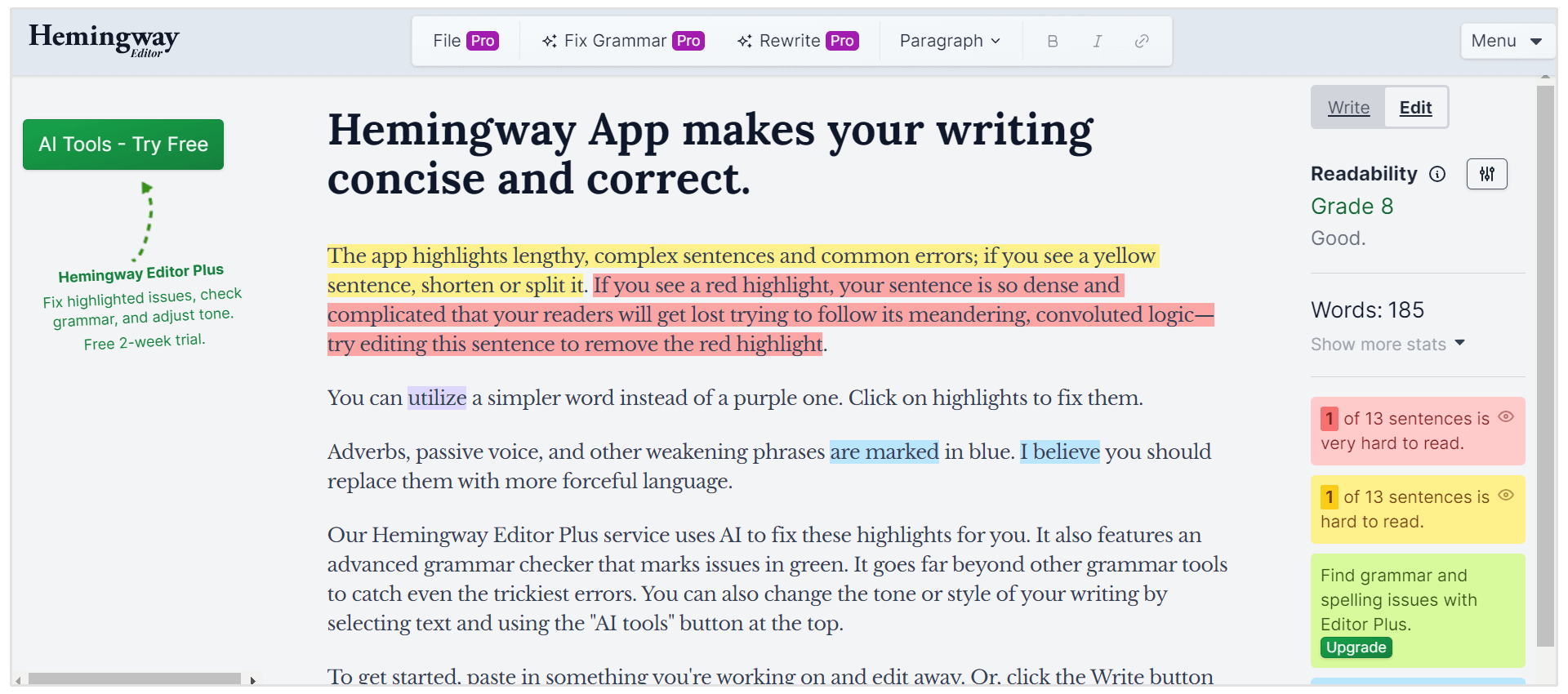
Additionally, a well-structured outline can improve your SEO efforts by helping you strategically place keywords, ensuring your content is both reader-friendly and search engine optimized.
Now, let's take a closer look at how to write a blog post outline.
How to Write a Blog Post Outline in 5 Steps
Decide on the Topic of the Blog Post
The first step of creating a blog outline is deciding the topic of the post. The topic lays the foundation upon which your entire post will be built.
Take your time to brainstorm and select a topic that aligns with your target audience's interests and needs.
Ideally, you already know about a few topic ideas that are popular in your niche, these are a good starting point.
Any SEO will tell you that you should begin with keyword research when trying to decide on a topic for your blog outline.
If you want to learn more about the entire keyword research process, check out this handy guide on how to find the best focus keywords for your blog outline.
Create a Blog Post Title
Once you've nailed down the topic for your blog post, it's time to work on creating the perfect title for the blog outline.
A good title helps you by guiding the direction of your writing and staying focused on the key points that you want to discuss in the post.
So how do you write the perfect title?
Here are a few key traits that all the best titles have:
- Use strong words or pose a compelling question to draw readers in.
- Keep it short and to the point. The best titles are concise, usually around 6-12 words.
- Clearly communicate what the reader can expect from the blog post.
- Incorporate numbers to offer a clear promise of what readers will gain, such as "5 Tips" or "10 Strategies."
- Use target keywords to improve searchability.
Determine the Blog Post Format
After deciding on the topic and writing your title, the next step is to determine the format of your blog post. The format you choose will influence how you structure your content and present your ideas.
Here are some common blog post formats:
- How-to guides: Step-by-step instructions that help readers accomplish a specific task or learn something new.
- Listicles: Posts that are organized as a list of tips, tools, reasons, or examples. These are easy to scan and read.
- Reviews: Detailed evaluations of products, services, or tools, often comparing features, pros, and cons.
- Case studies: In-depth analyses of specific examples or real-life scenarios that provide insights or lessons learned.
- Interviews: Q&A format posts featuring experts, influencers, or people with unique perspectives.
- Opinion pieces: Articles that express your thoughts, beliefs, or take on a specific topic or issue.
- Comparison posts: Posts that compare two or more products, tools, or methods, helping readers make informed decisions.
- Checklists: Organized lists of steps, tips, or items that readers can easily follow or use.
So, how do you decide which format to use? A great starting point is to analyze the top-ranking articles for your chosen topic.
Since these posts are already performing well, it means Google likes both the content and also the format in which the information is being presented.
I start creating my blog outlines by reading through the top three websites for my keyword of choice, finding the patterns in the content I'm reading.
- Aaron Wertheimer, SEO Copywriting Specialist at Marketing-Reel
While you don’t have to copy the exact format, following a similar structure can increase your chances of ranking well.
For instance, this post that you’re reading serves best as a how-to article, and by looking at the SERP for the target keyword, you’d think the same.
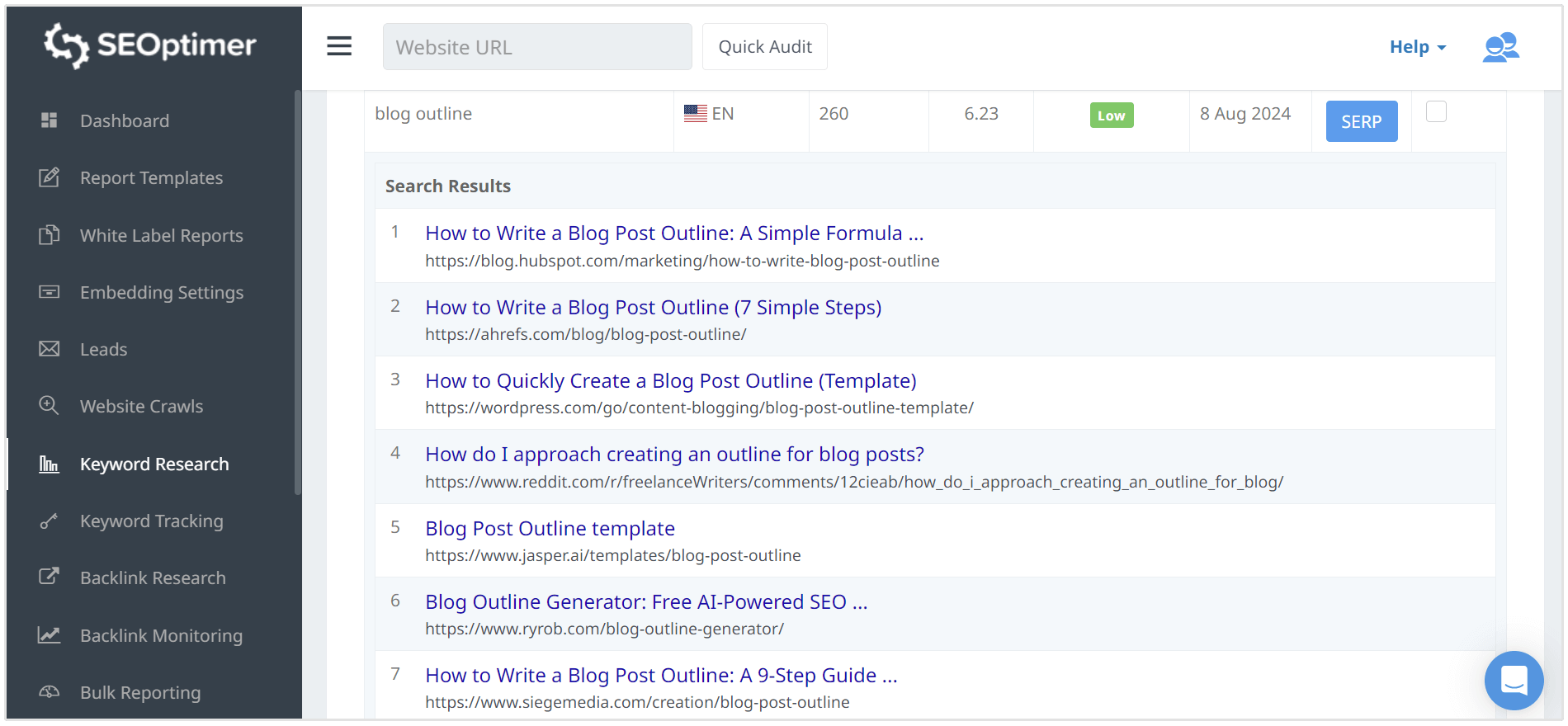
As you can see from analyzing the SERP using our Keyword Research Tool, almost all of the top ranking blog posts start with “How to”, this signals to me that users are searching with the intent of finding steps on how to create a blog outline.
However, if you’re targeting something like “long tail vs short tail keywords” then you’re going to go for a comparison format where you compare the differences between long tail keywords and short tail keywords.
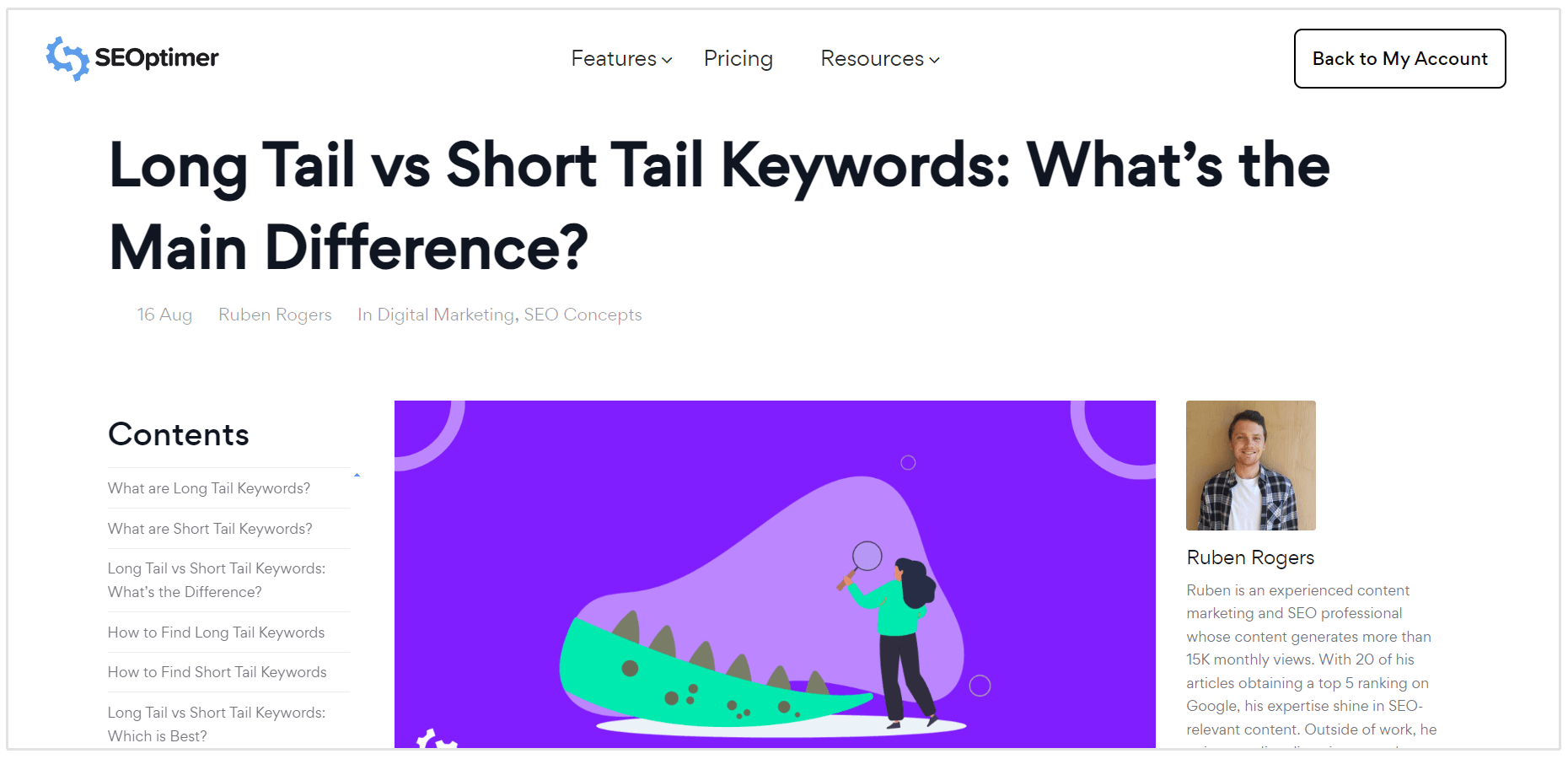
Now, it’s not uncommon to mix content formats in some of your blog posts. You might have a how-to article with some case studies at the end.
So it depends on the nature of the keyword you’re targeting.
Add All the Main Points to the Blog Outline
Once you’ve decided on the format, the next step is to add all the main points to your blog outline. This is the bulk of the work involved in creating an effective outline and will form the backbone of your entire blog post.
To find the main points to include, start by asking yourself what key information your readers need to know about the topic.
Here are some ideas on how to find all the main discussion points:
- Research competitor content: Look at high-ranking articles on the same topic to see what points they cover. Take note of the headings and subheadings they use, as this can give you an idea of the essential topics to include.
- Keyword research: Review your primary and secondary keywords. Often, related keywords can suggest important points or subtopics that should be covered in your post.
- Brainstorm: Write down all the ideas, questions, or concepts related to your topic. Organize these into categories, and use them as potential main points.
- Consider the flow: Think about the logical flow of information from a reader’s perspective. What do they need to understand first? What questions might they have? What steps should they follow? Structure your main points to guide them smoothly through the content.
- Expert insights: If possible, incorporate insights or quotes from experts. These can add credibility and depth to your blog post and might highlight points you hadn’t considered.
On a side note, even though you can research your competitor's content for some ideas, you should never copy what they're saying.
If you’re writing a carbon copy of what already exists, you won’t compete in SEO or provide real value to users.
- Brandy Hastings, SEO Strategist at SmartSites
You should definitely follow their trend, but also do something a little original.
Remember SEO is testing, so do enough to keep Google happy, but also try and create a point of difference with your structure.
- Paula Glynn, Head of Digital Strategy at Pixelstorm
As you compile these main points, start organizing them into a clear, logical order in your outline.
Some bloggers and marketers take the other approach. Instead of determining the flow of ideas and sections, they only organise the discussion points once the piece is written.
If I’m struggling with an outline, I don’t try to stuff my content into a box before it exists. It often doesn’t make sense to break a post into sections until you know what you want to say, how long it will be, and how the topics will flow from one to the next. Often, that develops organically as you write, and outlines tend to snuff that natural flow and reduce the blog’s quality.
- Brooke Webber, Head of Marketing at NinjaPatches
Each main point should have its own section in the blog post, and you can further break these down into sub-points as needed.
By doing this you will make the actual writing process much easier and ensure that your content is comprehensive, well-structured, and valuable to your readers.
Insert Google People Also Ask Questions (if Applicable)
Adding Google "People Also Ask" (PAA) questions into your blog outline can be a powerful way to enhance your content.
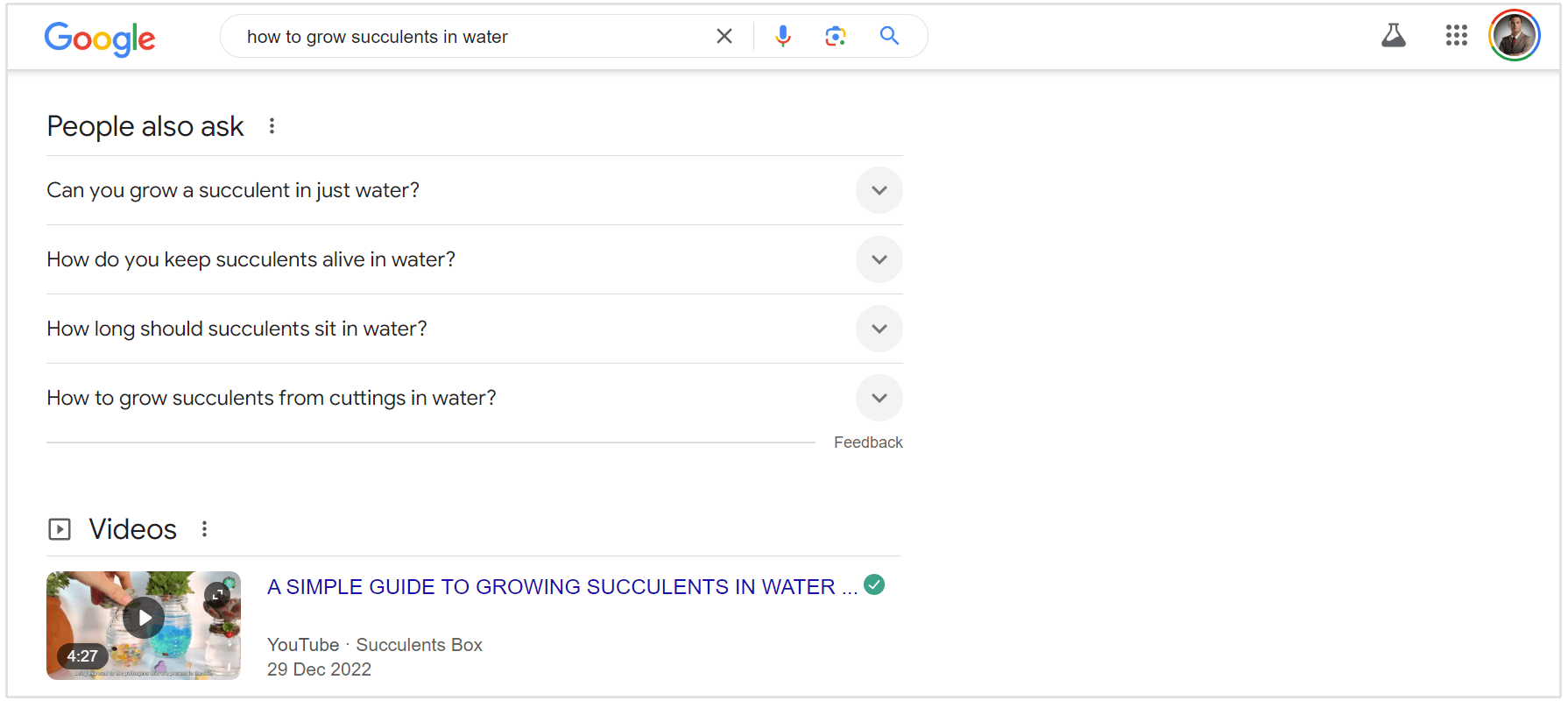
PAA questions are a valuable resource because they reflect the exact queries that real users are asking on Google.
By answering these questions in your blog post, you can directly give your audience the information they want to know.
When you Google your topic, look at the featured questions in the Google Answer Box, which gives you common FAQs from your audience. Whether you use these questions directly in your blog or simply use them to guide your outline, they give you keen insights into how your target audience thinks and asks questions.
- Elisa Montanari, Head of Organic Growth at Wrike
Note: not all searches will have PAA questions. If this is the case, I'd use a tool like Answer the Public to find alternative questions that are relevant to the target keyword.
What are the 4 Main Parts of a Blog?
The four main parts of a blog are:
- Introduction: The opening section that grabs the reader’s attention, introduces the topic, and sets the tone for the post. It often includes the main keyword and a brief overview of what the reader can expect.
- Body: The core of the blog post where you present the main points, arguments, and evidence. This section is typically divided into headings and subheadings to make the content easy to follow and digest.
- Conclusion: The closing section that summarizes the key takeaways, reinforces the main message, and often includes a call to action (CTA), encouraging readers to engage further with your content or website.
- Call to Action (CTA): A prompt at the end of the blog post that encourages readers to take a specific action, such as subscribing to a newsletter, signing up for a trial, sharing the post, or leaving a comment. You should also try adding CTAs all throughout the blog post. For instance, we tend to include links to key product pages and features (SEO Audit, Backlink Checker, Keyword Tracking, etc.) all throughout the blog post.
Strategically positioning CTAs in your outline will guide the flow of your blog and improve the reader's journey by providing clear next steps leading to better conversions.
- Maurizio Petrone, Founder at PressHero
Conclusion
Creating a blog outline is an important step in producing SEO content. If you want to produce stellar content, a blog outline will help you in gathering all your thoughts and ideas into one central document.
Blog outlines are key to scaling your content production efforts.
As you'd imagine, most SEOs and marketing professionals also use blog outlines when creating content briefs for their in-house and outsourced writers.















